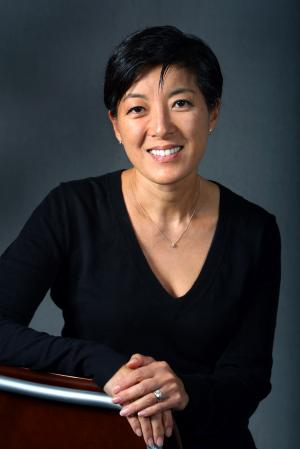Reducing Obesity, Cancer Deaths
$7 Million in Federal Grants Help in Fight to Prevent Health Problems in Pacific Islander Community
SORA PARK TANJASIRI, professor of health science, recently garnered nearly $7 million in grants to fund efforts to prevent obesity and cancer deaths in the Pacific Islander community over the next five years.
 Caption: Sora Park Tanjasiri has garnered nearly $7 million in grants to fund efforts to prevent obesity and cancer in Pacific Islanders. Photo by Karen Tapia
Caption: Sora Park Tanjasiri has garnered nearly $7 million in grants to fund efforts to prevent obesity and cancer in Pacific Islanders. Photo by Karen Tapia
“Through research studies, evaluation, education campaigns and training, we’re hoping to reduce obesity and promote early cancer detection among this very medically underserved population in Southern California,” said Tanjasiri, director of Cal State Fullerton’s Center for Cancer Disparities Research.
Continuing WINCART Research
As part of a $4.1 million WINCART (Weaving an Islander Network for Cancer Awareness, Research and Training) center grant, being funded at about $820,000 each year through 2015 by the National Institutes of Health/National Cancer Institute’s Center to Reduce Cancer Health Disparities, Tanjasiri will build on the last five years of her WINCART research.
“In the first five years, we built a network, partnered with Pacific Islander community groups and several universities throughout Orange, Los Angeles and San Diego counties,” she said. “We trained community leaders and promoted awareness of cancer prevention. Now, we’re taking it to the next level.”
According to the 2000 Census, there were 874,414 Pacific Islanders living in the U.S. California counts 221,458 Pacific Islanders, with half that number living in Southern California. Pacific Islanders represent a wide diversity of ethnic populations, Tanjasiri noted, from such places as Samoa, Guam, the Federated States of Micronesia, Commonwealth Nations of the Mariana Islands and small island nations.
“Despite their differences in nationalities, Pacific Islanders generally face high socioeconomic and other barriers to health care,” Tanjasiri said. “These mean critical disparities in cancer mortality and morbidity compared to nearly every other racial group in California.”
For instance, she said native Hawaiians, American Samoans, Chuukese and Palauans have been found to have rates of tobacco use: between 42 and 58 percent among men, and up to 67 percent among women. Smoking is the single most preventable contributor to cancer, and leads to lung cancer and other severe health problems, Tanjasiri said.
A 2004 study for the California Departments of Justice and Education found that among high school seniors, the heaviest daily smoking was observed for Hawaiians (35 percent) and Samoans (30 percent), compared with Koreans (19 percent), Filipinos (16 percent), Japanese (12 percent) and Chinese (5 percent) youth.
Obesity also has been implicated as a factor in the onset of cancer (including breast, colon, endometrium, esophagus, and kidney cancers), and rates of obesity are high in Pacific Islander populations.
A 2008 WINCART assessment of Pacific Islander young adults in Southern California found that 76 percent of Samoans and 84 percent of Tongans were overweight. Obesity in Pacific Islanders is linked to nutrition and physical inactivity, and culturally-mediated images of strong and healthy bodies, which must be addressed if obesity is to be reduced, Tanjasiri said.
She said Pacific Islanders also have “exceedingly low levels of cancer early detection.”
Tanjasiri and another researcher at Claremont Graduate University will be conducting studies to promote tobacco cessation, obesity and other cancer prevention education, and explore the ethics regarding collection of genetic materials among Pacific Islanders, who have already been found to have more aggressive tumorous cell growth in comparison to other racial/ethnic groups.
Increasing Pap Testing
In addition to her WINCART grant, Tanjasiri also garnered a $2,678,046 grant from the National Institutes of Health to convince more Pacific Islander women to get Pap tests (gynecological screenings that detect cervical cancer, infections and abnormalities). The grant is being funded at $557,000 this year and the rest will be split each year through 2015.
“Pacific Islanders experience high rates of cervical cancer mortality and low rates of Pap tests,” Tanjasiri said.
She said she and her fellow researchers from Cal State Fullerton and community partners — Guam Communications Network, Samoan National Nurses Association, Tongan Community Service Center and Orange County Asian and Pacific Islander Community Alliance — will develop culturally sensitive strategies that aim to convince women to routinely see a gynecologist and get a Pap test.
Tanjasiri said it is known that women who have a social support network of people who encourage the screenings are more likely to get them. So, the women and their husbands and families will be targeted.
Among other interventions, “we will create brochures and develop a 10-minute DVD (dubbed in Chamorro, Tongan and Samoan) using Pacific Islander professionals and tailored to women and men that models social support discussions about Pap testing, including what the test is, how it can prevent cancer, how often women should be tested, and how to get a Pap test,” Tanjasiri noted.
More Screening
In related research, Tanjasiri will conduct a two-year study to increase colorectal cancer screenings among Chamorros, Marshallese and Samoans in Orange County. The effort is being funded by a $122,857 grant from the National Cancer Institute.
The study, Tanjasiri said, pairs community health educators with Pacific Islanders at St. Joseph Hospital of Orange’s Cancer Prevention and Treatment Center to reduce delays between cancer education, early detection, diagnosis and treatment.
“This is an extension of the kinds of cancer education and early detection disparity studies I have conducted in the past,” Tanjasiri said. “When you promote screening, you naturally have to figure out better ways to diagnose and treat those who screen positive for cancer. It’s all about figuring out sustainable community-based solutions to ensure that everyone has access to the best cancer prevention, early detection and treatment options in the country.”
October 20, 2010
